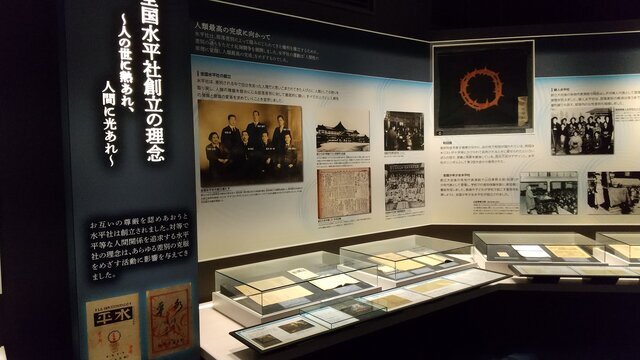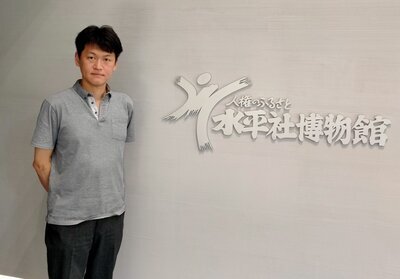- TOP
- 国際人権基準の動向
- FOCUS
- December 2022 - Volume 110
- 100th Anniversary of the Suiheisha Declaration and the Suiheisha History Museum
FOCUS December 2022 Volume 110
100th Anniversary of the Suiheisha Declaration and the Suiheisha History Museum
On 3 March 1922, people of the discriminated Buraku communities came together to found the Levelers Association (Suiheisha). The Founding Declaration of the National Levelers Association (Suiheisha Declaration), proclaimed at its founding meeting held at the Kyoto City Hall, is the first declaration on human rights in Japan, and is also said to be the first human rights declaration proclaimed by a discriminated minority.[1] The document has not lost its radiance and continues to resonate in our hearts because it not only denounces discrimination but also proclaims the liberation of the discriminated people themselves. When people are discriminated against, it gives them feelings of inferiority, and self-denial. The Levelers Declaration calls on the Buraku people to unite, and states that "(t)he time has come when we can be proud of being Eta," using a term which is now recognized as being discriminatory. I believe it is an expression arising from a desire to urge people to accept their social identity and to recover their human dignity.
This is why the Levelers movement was able to connect and find solidarity with the Hyeongpyengsa movement led by the Baegjeong, a discriminated minority in Korea, and to sympathize with other discriminated minorities, such as the Ainu, people recovering from Hansen's disease, and people of Okinawa. Regrettably, from a gender perspective, the Declaration includes expressions such as "manly martyrs of industry" and "brothers," indicating a conscious call by men exclusively to men, and revealing the limitations of the Levelers Association. But even in those times when women's status was notably lower, the Women's Levelers movement was launched, with efforts by respected women activists.
Suiheisha History Museum
The Suiheisha History Museum opened 1998 in Kashihara, Gose City in Nara Prefecture, the birthplace of the National Levelers Association. The Levelers Declaration was drafted by Saiko Mankichi, one of the founders of the National Levelers Association. Along with Saiko, other founders of the Association such as Sakamoto Seiichiro and Komai Kisaku are also from Kashihara, making this area the origin of the Levelers movement.
The Museum reopened after refurbishment to commemorate the 100th anniversary of the Declaration. In doing so, two points were borne in mind. One was to maintain the information at a level that junior high school students could understand, and to change the stereotypical image of "human rights" and "discrimination" as being something serious, heavy and dark, to embrace a wider audience. Efforts were made to actively include comics, picture books and song lyrics in the exhibits so that people can relate to the issues, and find interest in human rights and discrimination. The other point was to broaden the contents from mainly pre-war materials to include human rights issues such as the Buraku liberation movement after WWII and the current Buraku discrimination.[2]
 Exhibit Corner 3, "The ideals of the National Levelers Association."
Exhibit Corner 3, "The ideals of the National Levelers Association."
Today, hate speech and information inciting prejudice against the Buraku people and community abound on the internet, while the tendency to avoid marrying someone from the community remains.
In order to eliminate the continuing Buraku discrimination, I hope that the Suiheisha History Museum would be used more in school education. It is my dream that one day, some of the children who visit us would want to become museum curators. This museum is run without any government assistance and is privately funded.
In 2015, I participated in the Federation of International Human Rights Museums annual conference held in Wellington, New Zealand for the first time, and in December that year, the Suiheisha History Museum joined the Federation as the first museum in Japan to do so. The Federation is a loose network of human rights museums around the world that was established in 2010 by the initiative of the International Slavery Museum, which is a part of the National Museums Liverpool in the United Kingdom.
In 2016, documents recording the solidarity between the Levelers Association and Hyeongpyengsa held by the Museum was registered in the UNESCO Memory of the World Regional Register for Asia/Pacific. The discriminatory ideas of the class system of the Joseon dynasty remained in the Korean Peninsula under the Japanese colonial rule. Similar to the Buraku people since the Meiji era, the Baegjeong people were also equal under the law, but discrimination against them remained. Hyeongpyengsa was founded in 1923, and the history of both the Levelers Association and Hyeongpyengsa leading the movement for a more just society lends courage to the achievement of peace and human rights in East Asia where politically difficult conditions prevail.
The Declaration closes with the line, "(l)et there be warmth in human society, let there be light in all human beings" which is emblematic of its ideals. I hope to continue spreading the message of the footprints of people who fought for a society in which human dignity and equality is achieved.
 Director Komai Tadayuki standing by the entrance to the exhibition rooms of the Museum.
Director Komai Tadayuki standing by the entrance to the exhibition rooms of the Museum.
Komai Tadayuki is the Director of the Suiheisha History Museum.
For further information, please contact: Komai Tadayuki, Suiheisha History Museum, ph: 81-745-62-5588, fax: 81-745-64-2288, e-mail: suihei@mahoroba.ne.jp; www1.mahoroba.ne.jp/~suihei/eng/index.html.
[1] See full text of the English version of the Suiheisha Declaration here www.hurights.or.jp/archives/other_documents/section1/1922/04/declaration-of-human-rights-in-japan.html and the original text in Japanese here「水平社宣言」www1.mahoroba.ne.jp/~suihei/sengen.html
[2] Suiheisha History Museum website (水平社博物館のウェブサイト), www1.mahoroba.ne.jp/~suihei/.
